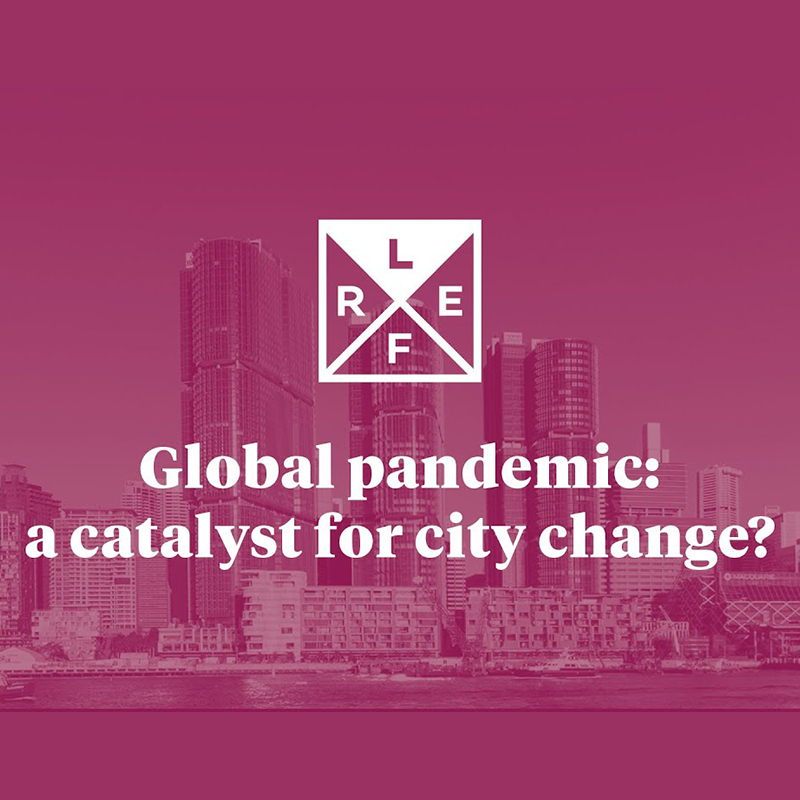How can a catastrophe be a catalyst for positive change? The COVID 19 pandemic has disrupted normal life across the world, but many cities have used the situation to fast-track changes to improve urban life. Top urban planners from New York, Sydney and Singapore discuss changing workplaces and commuting, innovative planning initiatives, and re-inventing the use of city streets and the urban realm.
This webinar, chaired by Greg Clark, took place in the leadup to World Cities Day on 31 October 2020, with the theme Valuing our Cities & Communities.
Chaired by Greg Clark, the webinar discussed how cities have been able to build on the situation and fast-track change, changing patterns of working and commuting, innovative planning initiatives, and re-inventing the use of city streets.
Some key points discussed:
- ‘We need to reinvent what the city needs to be for its residents in the future, not just try to recreate where we were just six months ago.’
- Flexible use of spaces: in Singapore, several spaces converted to care units, whether quarantine or other spaces. Hotels were converted to quarantine spaces, and a dance club was converted to cycling studio in the day and cinema at night.
- To help the tourism industry, Singapore envisages a domestic tourism campaign to encourage locals to spend locally, and creating safe travel bubbles.
- ‘There was a willingness to try things that government was maybe hesitant to try before.’ During the pandemic, Sydney has fast-tracked the planning process – to enable projects that could both create jobs and public benefit.
- Public space curation focused on assisting public space and keeping it safe while still using it, for instance keeping beaches open but with safety measures in space. for instance. Pedestrianisation ‘All parks were made car free.’
- Seizing on the opportunity of and using spaces otherwise occupied by traffic. Sydney organised The Festival of Place with events such as dance performances in now empty streets
- ‘We were using the pandemic to do things you wouldn’t normally be able to do in peacetime, and creating a legacy.’
- New York took the opportunity to reclaim the road, allowing restaurants to occupy pavements and parking spaces. Streets close to parks and public spaces were closed to act as extensions of those spaces.
- The last few months have seen the growth of micro-mobility in New York. Before everyone travelled by Subway, and now you see more cycling, vespas, scooters, and people taking the bus.
- The cluster of businesses in cities have resulted in collaborations that have added to the ities’ resilience. An example from New York is design studios doing pro-bono work for restaurants, and adapting outdoor spaces
- A long-standing ambition in many cities has been to re-distribute jobs from CBD to other areas. Now, with many people working remotely, cities are re-thinking where businesses can be based.
- What is the purpose of the office spaces? Much of our work can be conducted online, but physical meeting spaces are still important. ‘Serendipitous encounters take place in the city, and make the cities exciting.’ ‘Think of offices as Interaction machines.’
- Employers in the innovation sector are realising this, and in New York ‘We are seeing big companies making bets on people coming back into the office eventually with big leases being signed by Facebook and Amazon for instance’
- The CBD in Sydney sees less than 30 % occupancy at the moment. If people will not come to the city centre to work in the future, ‘We need to encourage people to look at the city as a place where people can come to play and not just work.’
- ‘Mixed use makes city centres more resilient to shock.’ A lot of the budget for NY planning comes from real estate property taxes and commercial taxes; therefore it is important for fiscal life for the city to have a smooth transition from one use to the other in a city.
- Converting office buildings for residential use is one part of it. ‘We want to move away from a CBD that just caters for work, and we are trying to make them more attractive places for living and play.’
- We are moving from cities with only one centre to a model with a better spread. ‘We are looking at bi-directional travelling rather than tidal travel’.
- ‘We need to understand the city’s DNA and strengthen its sense of place and create experiences that are unique and cannot be replicated online.’
CHAIR:
- Prof. Greg Clark CBE, Global Advisor, Chair, Author
INVITED SPEAKERS:
- Alex O’Mara, Group Deputy Secretary, Department of Planning, Industry & Environment, New South Wales, Sydney
- Cecilia Kushner, Executive Vice President for Planning, New York City Economic Development Corporation
- Yu-Ning Hwang, Chief Planner, Singapore
